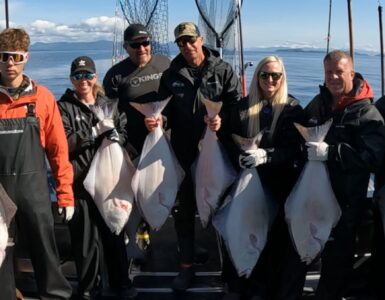Thanks for tuning into KSL Outdoors, I’m Adam Eakle, along with Mickey Anderson from Fish Tech. You know you and I were talking the other day. It’s gotten pretty warm, it’s time to get off the ice and go to the river. Yeah, I’ve been waiting for this. Let’s go see what it’s doing. The river has been frozen, warm temperatures should clear the ice off. Ok, where are we headed? Let’s run up to the Weber, see what is going on up there. Long stretch there to check out, about a dozen flies you hooked me up with. They better work! I don’t care. As long as mine do. Alright. We’re headed up to the Weber.
I’m surprised how warm it is. It’s nice. It’s 50 degrees out here. For early February!
So what do you think right here. We’ve fished this before. Yeah, it’s normally a good stretch right through there. We’ll see if we’re going to get the, It’s wintertime. I’ll bet just a week ago this was frozen all the way across. Yeah, very few people have been out here. No. Alright what are you going to start with? My own little fly and a dart, red dart. Ok.
I just had a fish. Oh man. Lost him.
There’s one. Good one. Good one. Big old whitey. Be a whitey. That’s fine with me. Oh yeah, nice whitey. Cool. Love the whitey.
Do you think it’s possible that they are still in that winter pattern of deep holes? Yeah, the water is cold. Part of what we don’t know is what wasn’t a hole last week. Got him on the Flashbulb. Yes.
Now let’s see what he’s eating.
Oh. Something big in there.
Oh wow, he’s been eating. Lots of midges. There’s a sow bug. This bigger one is a sow. That could be a little tiny caddis.
Sows and little teeny caddis and I caught it on a great big attractor.
So for the next month or so, maybe even a little longer. We are going to see a lot of runoff with all of this snow we’ve had. We are going to have a lot of off color water. Yeah, there is, but it’s still real fishable. A lot of people won’t, but it’s still fishable if you remember a couple of things.
Oh there’s a fish. Little whitey. Nice. Oh and he got off.
What I’ve seen is first is slow. Sometimes slow water the fish can find food easier there. Work it slow, just keep casting it, work one hole over and over again, give the fish a chance to find it.
There’s a fish.
The next is shallow. The fish can see up, in the colored water and see a silhouette against the sky. So adjust your indicator up and I only fish about 20-30 inches deep in muddy water.
Yeah if I didn’t already have dinner plans, he would definitely be going home.
The next is shiny, add a little bit of flash. So my best rig I had a worm for an attractor fly and then a real flashy fly underneath and that flash fly was by far our best today.
There’s one. Good brown. Is that a big whitey? Brown, big brown. Wow. I missed him when he came by. Hit the line with my net and knocked him off.
Oh Mickey. That’s it, you’ve got to take a swim. That was a big fish. Yeah it was.
Boy a whitefish will save a lot of fishing trips. Man, he just does not want to come in.
There we go, nice little whitey.
Boy you know what. When you are not having a good day of fishing, like me. A whitefish will sure save a lot of fishing trips. Cool fish, get him back in the water and see if we can get another.
That was a nice brown trout you had for about two minutes, wasn’t it? Yeah, my hands just would have stunk to land him anyways. I’ll take the stink. Good deal, off color water is going to be around for quite a while it looks like. Yeah, I think all spring, we are going to have a lot of high, off color water. Ok, still a good time to get out and fish. We can still fish it.
Welcome back to KSL Outdoors, I’m Adam Eakle. You know all this snow we’ve been getting this winter is great. Great for fish, great for filling our reservoirs. But, it’s not so great for our four legged friends and that’s why the Division of Wildlife Resources and sportsman have decided to step up and give these deer a helping hand.
Right now we are feeding all over northern Utah.
Today we are in the Ogden Valley, Huntsville area.
For the first time since 2008, the DWR and hunters are coming together to initiate an emergency feeding program for deer that are struggling to survive the tough winter weather.
The intent is not to take over a deer’s diet, but to supplement the diet. Help them, give them energy to use surrounding browse.
One thing we did this year compared to 2008 and 1983 is we started feeding earlier. Colorado did a study a few years ago.
What they were looking is at adult doe survival and those are the animals we really want to target to save, because that is our breeding population and they found if they feed early and got it going quick enough that they did have an impact on increasing doe survival and also on recruitment on the following year because the doe were in better condition. We got to them early enough we hope? We hope.
Biologists go out on a weekly basis and monitor deer on their winter range. They look at snow depths. They look to see if the deer get to the available food, or is the snow crusted over. They monitor temperatures to see if they are below normal and they also monitor deer throughout the year to see what condition they are in.
Up in the Cache County for example we have 40 doe and 20 fawns that are collared so we’ll monitor their survival and compare that to other units where we are not feeding and see if it makes a difference.
Our sportsman organizations have come to the table in a big way to help out. The cost of feeding this winter. We’ll probably exceed 300,000 dollars in feed alone. It’s possible for us to jump in and buy food, but we need people on the ground, boots on the ground to get out there and help us get this food spread. This is a daily effort. It’s not a once and done thing. We just don’t have the staffing levels to go in and get all this feeding work in. That’s when the call went out to our sportsman to the Mule Deer Foundation, Sportsman for Fish and Wildlife, Rocky Mountain Elk Foundation. We have their members and organizations all throughout the state.
In addition to sportsmen, landowners also pitched in. With barns to house the feed. Machinery to plow areas so that these deer could get to the twenty deer feeding areas.
I can’t say enough thanks to the landowners for supporting public deer on their properties. They are paying ranch hands to feed cattle and deer at the same time.
Will all of this effort biologists and sportsmen admit they may only save a few hundred, maybe a few thousand deer? But they say, they couldn’t just stand around and do nothing.
It’s worth it if it doesn’t work. Because then we know we went down swinging. We didn’t stand there and say well you know we should have tried something. We did something, we put our money where our mouth is. We mobilized, we put people in action, we got together, we put the feed out there and if they don’t eat it or benefit from it. At least we went down swinging. Nobody can say nobody tried.
Next up, it’s upland game hunters who take to the hills to help struggling birds. But first back to the guys at Fish Tech for tonight’s fishing report.
Welcome back to KSL Outdoors, I’m Adam Eakle. You know it’s not just deer that are struggling with this harsh winter we are having here in Northern Utah. Here in Box Elder county and even up in Cache County its upland game species like partridge and even sharptail grouse that are struggling. So, hunters have decided to put the shotguns down and grab some feed and help the birds out.
So Box Elder county and Cache county are really hating it, there is no exposure on south facing slopes. Chukars absolutely have to have access to the ground in order to survive the winter. They have to get down and get to those little cheat grass shoots that are about this tall. If the sun doesn’t come out and melt those slopes, we don’t have any way for chukars to get feed.
In some areas we were afraid we were going to lose an entire chukar population in a particular mountain range. So we wanted to try and feed them to get enough chukars by that we would have enough to re-populate wild birds without having to re-introduce them later.
So we put the call out and what is so amazing about it, is look how many people we got out in just a couple of days time.
The division donated chicken scratch.
Everybody is coming and picking it up and going out to their feeding locations and sites.
Bret organized this effort over social media. In two days over two dozen hunters volunteered their time, and their equipment, not only feed the birds, but also forgo hunting in Box Elder and Cache County for the last two weeks of the season.
We can even load the sled up if you want and just drag it around to some stations.
We called the DWR and tried to get an emergency closure which they couldn’t grant us, sadly.
I think it will work. I’m hopeful anyway. You’ve got to be optimistic. We all like to pursue the wildlife and once in a while you get in a situation where you have to do your part to try and promote preserving the wildlife, versus just going out and harvesting all the time.
Here on Kolten’s family property, huns were doing their best to survive by eating with the cattle. Many areas we found chukars right on the road trying to find anything they could to eat.
The idea behind what we are doing today is move birds so that they are off the roads so they are a little less vulnerable. Also if we can keep a few birds alive through the winter into the spring then there will be at least a breeding population left in these areas.
As hunters we are the biggest stewards of wildlife there is. If it weren’t for hunters dollars and efforts and deals like this where hunters get together and pool their resources.
Then there wouldn’t be any animals at all. The resource is protected by hunters.
Chukar hunters are amazing guys.
This feed has only been here for about an hour and I kicked about 20-30 birds on my walk in here. So, they are already finding some of this feed. Hunters know they are not going to save all the population, but they sure hope to save some of the population in some of these areas that they are struggling. More here on KSL Outdoors in a moment, but first down a different trail in tonight’s Utah Field Guide.







Add comment